

How to Create an Onboarding Checklist for New Employees
Użyj tego szablonu, aby wyposażyć swoich nowych pracowników do osiągania sukcesów, uprościć onboarding i dłużej zatrzymywać pracowników.
Dobrze przeprowadzony onboarding prowadzi do tego, że 58% nowych pracowników zostaje w firmie przez co najmniej trzy lata. Najlepszy proces onboardingu znajduje równowagę między potrzebami pracownika, pomagając mu wczuć się w kulturę firmy, a praktycznymi momentami, które są nieplanowane.
Wydałeś dużo pieniędzy i czasu na rekrutację idealnego pracownika. Dziś jest ich pierwszy dzień i chcesz zrobić świetne wrażenie. Jeśli wszystko dobrze pójdzie, będą mniej zestresowani, szybko się osiedlą i staną się cennym członkiem Twojego zespołu. Jeśli się pomylisz, mogą odejść po kilku miesiącach, ponieważ będą sfrustrowani i nie będą mieli narzędzi do osiągnięcia sukcesu.
Niestety, niewielu menedżerów zatrudniających właściwie przeprowadza onboarding. Według Gallupa, tylko 12% pracowników jest zadowolonych ze swojego onboardingu. Raport HBR pokazuje również, że 23% pracowników odchodzi przed rocznicą swojej pierwszej pracy. Wynika to z tego, że zły proces onboardingu prowadzi do niższej morale, mniejszej pewności siebie, niskiego zaangażowania pracowników i braku zaufania do organizacji.
Dobry proces onboardingu zapewnia nowym pracownikom narzędzia i zasoby, których potrzebują, aby efektywnie wykonywać swoją pracę. Zmniejsza również rotację, pomaga nowym pracownikom zrozumieć, czego się od nich oczekuje, i ułatwia budowanie relacji między współpracownikami.
Ten artykuł daje Ci wszystko, co potrzebne do stworzenia skutecznego procesu onboardingu, zaczynając od listy kontrolnej onboardingowej, abyś mógł się zorganizować. Zapewnia, że Twoi nowi pracownicy nie czują się przytłoczeni w swoim pierwszym dniu, ale są ostrożnie prowadzeni przez proces poznawania kultury Twojej firmy, zrozumienia zadań i uzyskiwania potrzebnego wsparcia w rozwoju.
Czym jest onboarding?
Onboarding to proces, w którym nowi pracownicy nabywają umiejętności, wiedzę i możliwości potrzebne do stania się produktywnymi pracownikami organizacji.
Jednak onboarding to coś więcej niż tylko dostarczanie materiałów szkoleniowych i podpisywanie dokumentów. Zrobiony prawidłowo, to pierwszy krok w budowaniu lojalności wobec Twoich pracowników, co oznacza, że prawdopodobnie zostaną na dłużej.
Według HRCI, dobrze przeprowadzony onboarding prowadzi do tego, że 58% nowych pracowników zostaje w firmie przez co najmniej trzy lata. Glassdoor również stwierdza, że solidny proces onboardingu może pomóc nowym pracownikom osiągnąć do 70% wydajności po rozpoczęciu nowej pracy.
Jednak skuteczny proces onboardingu to nie tylko wypełnianie dokumentów i dyktowanie zasad. To Twoja okazja jako menedżera, aby zrobić wspaniałe pierwsze wrażenie i pokazać nowym pracownikom, że wybrali właściwą firmę.

Czym jest lista kontrolna onboardingowa?
Lista kontrolna onboardingu to sposób, w jaki menedżerowie zatrudniający organizują kroki związane z wprowadzaniem nowych pracowników na ich pierwsze dni i miesiące w firmie.
Lista kontrolna zapewnia punkt wyjścia dla procedur specyficznych dla określonego stanowiska. Należy jednak zauważyć, że wypełnienie listy kontrolnej onboardingu niekoniecznie przekłada się na skuteczny onboarding.
Najlepszy proces onboardingu znajduje równowagę między potrzebami pracownika, pomagając mu wczuć się w kulturę firmy, a praktycznymi momentami, które są nieplanowane. Najlepszy proces onboardingu znajduje równowagę pomiędzy potrzebami pracownika, pomagając mu wczuć się w kulturę firmy, a praktycznymi momentami, które są nieplanowane.
Co należy uwzględnić w liście kontrolnej onboardingu?
Oto kilka rzeczy, które powinna zawierać każda lista kontrolna onboardingu:
- Proces rekrutacji
- Rola pracownika
- Ustalanie celów
- Szkolenie w pracy
- Wprowadzenie do kultury firmy
- Terminy na konsultacje
- Spotkanie z innymi pracownikami lub przełożonymi
- Dokumentacja
- Poznawanie produktu
Lista kontrolna przed onboardingu
Według Aberdeen, firmy, które przeprowadzają pre-onboarding zatrzymują 81% nowych pracowników w pierwszym roku zatrudnienia.
Celem jest poinformowanie nowych pracowników, czego mogą się spodziewać w pierwszych dniach i czego firma oczekuje od nich w dłuższym okresie. Zobacz, jak Asana prowadzi swój proces pre-onboardingu.
Wyślij powitalny e-mail do nowego pracownika
Powitalny e-mail to dokument, który wysyłasz do nowego pracownika, aby go przywitać i przygotować na jego pierwszy dzień. Twoim celem jest, aby poczuli się doceniani i zaakceptowani jako część Twojego zespołu. Będziesz także musiał dostarczyć przydatne szczegóły, takie jak co się wydarzy i gdzie należy pójść.

Pisząc powitalny e-mail, potwierdź szczegóły, takie jak lokalizacja biura (dla ról hybrydowych lub stacjonarnych), data rozpoczęcia i godzina. Powiedz im, do kogo mają się zgłosić i czy powinni coś zabrać ze sobą, takie jak informacje dotyczące zabezpieczeń społecznych i dane bankowe.
Ogólnie rzecz biorąc, chcesz, aby pracownik czuł się optymistycznie i podekscytowany pracą z Tobą, a nie wystraszony i przytłoczony.
Oto kilka sposobów na dostosowanie swojego e-maila:
- Bądź osobisty
- Pokaż ekscytację
- Rozważ formatowanie
- Pokaż ducha swojej firmy
- Zapytaj ich, czy mają jakieś pytania lub wątpliwości dotyczące swojego pierwszego dnia
Porada: Rozważ przypisanie swojemu nowemu pracownikowi kolegi. Niech się z nimi skontaktuje, aby powitać nowego pracownika i ustalić czas na przywitanie oraz odpowiedź na wszelkie pytania.
Wyślij e-mail do istniejących pracowników
E-mail do istniejących pracowników to okazja, aby poinformować zespół o nowym pracowniku. Podziel się szczegółami na temat doświadczenia zawodowego pracownika, tła, edukacji i zestawu umiejętności. Zbuduj pozytywny wizerunek, aby pracownicy mogli łatwiej nawiązać relacje z nowym pracownikiem.
Zachęć również członków zespołu do dzielenia się swoją wiedzą i spędzania czasu na przedstawianiu siebie i tego, co robią w firmie.
Omów role i cele z przełożonym
Do kogo nowy pracownik będzie się zgłaszał? Jakie będą ich obowiązki i odpowiedzialności? Upewnij się, że omówiłeś to z ich przełożonymi i innymi zainteresowanymi stronami.
Przygotuj biuro dla nowych pracowników
Bez względu na to, czy to biurko, sala czy stół, upewnij się, że jest gotowe i wyposażone przed rozpoczęciem pracy nowego pracownika. Kiedy nowy pracownik zobaczy, że ma przygotowane dedykowane miejsce pracy, pokaże to, że włożono wysiłek w to, aby poczuł się mile widziany.

Listy kontrolne onboardingu pracowników
Agenda onboardingu na pierwszy dzień
Wycieczka po biurze
Zakładając, że nie są to pracownicy wykonujący pracę zdalną, w pierwszym dniu zapewnij nowym pracownikom zorganizowaną wycieczkę po firmie i przedstaw ich współpracownikom. Poza pokazaniem im, gdzie co jest, wycieczka powinna także sprawić, że Twoi nowi pracownicy będą entuzjastycznie nastawieni do codziennego przychodzenia do pracy. Więc jeśli masz fajny pokój gier, centrum jogi lub jakieś innowacyjne urządzenia, z których jesteś dumny, nie krępuj się ich pokazywać.
Pomóż swojemu nowemu pracownikowi przygotować miejsce pracy
W biurze?
Pokaż im swoje nowe biuro, narzędzia, z którymi będą pracować, oraz współpracowników, z którymi mogą dzielić przestrzeń. Nie zapomnij podzielić się zasadami firmy dotyczącymi projektowania i dostosowywania miejsca pracy.
Pracujesz zdalnie?
Jeśli Twoja firma ma budżet na pomoc swojemu nowemu pracownikowi w stworzeniu komfortowego domowego biura, upewnij się, że podzielisz się wszelkimi wskazówkami w pierwszym dniu.
Poproś nowych pracowników o wypełnienie dokumentów HR
Gdy mają już biurko, zapewnij nowym pracownikom formularze HR potrzebne do złożenia dokumentacji dotyczącej płac, świadczeń, podatków i innych. Poinformuj ich, co należy zrobić w razie potrzeby pomocy w wypełnianiu formularzy.
Spotkanie z menedżerami i kierownikami
Po tym, jak nowi pracownicy zapoznają się ze swoimi współpracownikami i przetestują swoje stanowiska pracy, czas na spotkanie z kierownikami lub przełożonymi. Aby zaoszczędzić czas, zorganizuj otwarte spotkanie orientacyjne, na którym menedżerowie i kierownicy przedstawią się nowym pracownikom i podzielą się kilkoma słowami zachęty. W przypadku mniejszych firm spotkanie z menedżerami i kierownikami może odbyć się w formie indywidualnych spotkań.
Przydziel materiały szkoleniowe
Zapewnij swoim nowym pracownikom zasoby potrzebne do wykonywania swojej pracy i osiągania pożądanych wyników. Możesz użyć Guru, aby udostępnić dokumenty szkoleniowe i śledzić postępy onboardingu pracowników. Guru ułatwia pracownikom naukę we własnym tempie i pozwala Ci śledzić, co przeczytali.
Omów oczekiwania
Jak będzie determinowany sukces? Ustalenie jasnych oczekiwań wobec pracowników wyposażają ich w narzędzia do monitorowania swojej wydajności i dążenia do najlepszych wyników.
Omów kulturę firmy
Kultura firmy wykracza poza wytyczne i zasady, które pracownicy muszą przestrzegać wewnątrz i na zewnątrz miejsca pracy.
Silna kultura firmy nie tylko przyciąga najlepszych kandydatów, ale także pomaga zatrzymać pracowników. Komunikowanie kultury firmy podczas onboardingu pomaga pracownikom zrozumieć wartości firmy, ich role i to, jak się pokrywają. Kultura, którą pracownicy kochają, poprawia również wydajność, wyniki i zaangażowanie.
Przydziel mentora lub kolegę
Według Harvard Business Review, przydzielenie mentora during onboardingu zapewnia, że nowy pracownik będzie produktywny w ciągu pierwszych 90 dni w nowej pracy.
Programy mentorskie to świetny sposób, aby nowi pracownicy nauczyli się umiejętności praktycznych od starszych pracowników. Mentoring synchronizuje cele organizacyjne z celami zawodowymi pracowników i daje im poczucie zaangażowania, co prowadzi do zwiększonej satysfakcji z pracy.
Zabierz ich na lunch
Jeśli Twoja organizacja nie może sobie pozwolić na zabranie każdego nowego pracownika na wykwintny lunch, to zrozumiałe. Alternatywą jest uczczenie nowych pracowników napojami, przekąskami, brawami lub czymkolwiek innym, co pokazuje, że cieszysz się, że ich masz na pokładzie.
Lista kontrolna onboardingu na pierwszy tydzień
Onboarding nigdy się nie kończy. To ciągły proces od momentu przybycia nowego pracownika aż do dnia ich odejścia. Pierwszy tydzień to czas, aby upewnić się, że nowy pracownik jest zaangażowany w kulturę firmy i wzmocnić wartość, jaką w nich widzisz. W związku z tym zadania powinny być powiązane z kulturą korporacyjną.
Kilka rzeczy do zrobienia w pierwszym tygodniu onboardingu to:
- Codziennie sprawdzaj, jak przystosowują się do nowego środowiska pracy
- Zaplanuj szkolenie
- Pokaż im, jak korzystać z oprogramowania firmy
- Przedstaw im innych członków zespołu
- Rekomendacja przydatnych zasobów do rozwoju
- Organizacja aktywności towarzyskich, aby pomóc nowym pracownikom w nawiązaniu więzi z kolegami
- Wykorzystaj opinię pracowników do poprawy procesu onboardingu
Lista kontrolna onboardingu na pierwszy miesiąc
Kilka rzeczy do zrobienia w ciągu pierwszych 30 dni onboardingu obejmuje:
- Organizuj cotygodniowe spotkania z nowymi pracownikami
- Włącz ich w bieżące projekty, ale nic zbyt skomplikowanego
- Pomóż im poznać platformy specyficzne dla firmy, zasoby szkoleniowe i systemy intranetowe
- Dostarcz opinie na temat konkretnych zadań. Pamiętaj, aby postępować łagodnie, ponieważ wciąż uczą się
- Ułatw budowanie relacji
- Przeprowadź ankietę onboardową, aby określić, jak dobrze nowy pracownik zintegrował się z Twoją firmą
- Wykonaj przegląd postępów i zaplanuj odpowiednie szkolenie na podstawie wyników przeglądu
Lista kontrolna onboardingu na 90 dni
Po 90 dniach kilka rzeczy do zrobienia obejmuje:
- Zachęć swojego pracownika do samodzielnego pracy nad projektami i ponoszenia odpowiedzialności za swoją pracę
- Regularnie kontaktuj się z przełożonym w celu uzyskania opinii o KPI i metrykach na przyszłość
- Przeglądaj cele wydajności, aby upewnić się, że są realistyczne i osiągalne
- Zbierz opinie pracowników na temat programu orientacji nowych pracowników
- Kontynuuj ułatwianie socjalizacji i budowania relacji w organizacji
- Rozważ shadowing, jeśli Twój pracownik ma trudności z zaklimatyzowaniem się lub osiąganiem KPI
Lista kontrolna onboardingu na 6 miesięcy
Jeśli dotarli do kamienia milowego 6 miesięcy, to niesamowite! Zorganizuj ocenę wydajności, aby przeanalizować osiągnięcia i omówić cele do osiągnięcia w roku.
Przegląd po roku
Do końca roku nowy pracownik powinien być w pełni zintegrowany w firmie. Dawaj swoim pracownikom opinie na temat ich wydajności i pokaż im obszary, które mogą poprawić.

Szablony list kontrolnych onboardingu dla różnych działów
Nie musisz tworzyć listy kontrolnej onboardingu od podstaw. W Guru mamy kilka szablonów onboardingu, które możesz dostosować do potrzeb onboardingu swojego pracownika. Możesz przetestować nasz darmowy szablon onboardingu dla menedżerów HR, przedstawicieli sprzedaży, pracowników IT i pracowników zdalnych.
Szablon onboardingu HR
Szablon onboardingu Guru dla zasobów ludzkich zawiera listę działań na każdym etapie procesu onboardingu. Możesz stworzyć listę zadań, oznaczyć status każdego ukończonego zadania i dodać notatki.
Szablon onboardingu dla menedżerów
Menedżerowie powinni korzystać z tego szablonu listy kontrolnej, aby upewnić się, że obejmują każdy etap programu onboardingu. Szablon zawiera odpowiedzialności związane z onboardingu od wstępu, prowadzenia ich przez pierwszy dzień, zapewniania ocen wydajności i uzyskiwania opinii.
Szablon onboardingu dla zespołów sprzedażowych
Istnieje wyjątkowa kultura w zespole sprzedażowym, która wymaga unikalnego szkolenia. Skorzystaj z tej listy kontrolnej onboardingu sprzedaży, aby zakończyć szkolenie dotyczące marketingu, przypadków użycia produktów, misji firmy i taktyk sprzedażowych.
Szablon onboardingu dla IT
Bez odpowiednich narzędzi nowi pracownicy doświadczają niespójności, które uniemożliwiają im wykonywanie swojej pracy. Dział IT regularnie zapewnia wsparcie, aby zapobiec zmarnowanemu czasowi i zapewnić płynne onboardowanie. Skorzystaj z tej listy kontrolnej, aby upewnić się, że zespół IT zapewnia nowym pracownikom dostęp do firmowego konta e-mail, urządzeń do obliczeń, dostępu do systemów wewnętrznych i uprawnień do bezpieczeństwa.
Szablon onboardingu dla pracowników zdalnych
Onboarding pracowników zdalnych może być trudny, ponieważ wszystko odbywa się za ekranem. Jednak cele pozostają takie same. Widoczna różnica to brak spontanicznych okazji do tworzenia więzi zespołowych i osobistego uczenia się, które pomagają nowym pracownikom zorientować się w sytuacji.
Użyj tego szablonu onboardingu dla zdalnych pracowników, aby stworzyć proces onboardingu, który szybko wdroży nowego pracownika na właściwą ścieżkę.
Jak korzystać z Guru w onboardingu pracowników?
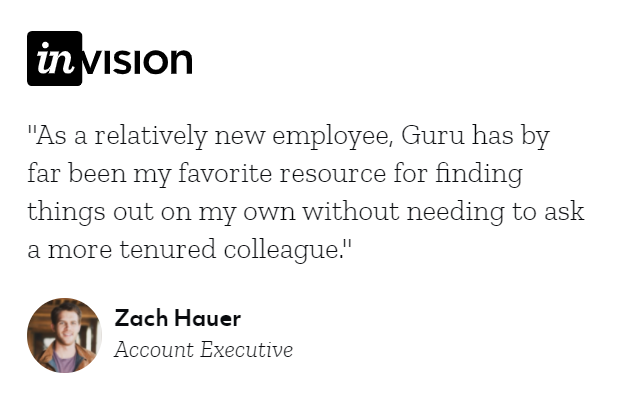
Elastyczny onboarding
Rozpoczęcie nowej pracy jest już stresujące. Szukając materiałów onboardujących na wielu platformach, staje się to jeszcze bardziej stresujące. Z Guru nowi pracownicy mogą uzyskać dostęp do całej wiedzy związanej z onboardowaniem z jednej centralnej platformy, zamiast poruszać się po oddzielnych rozwiązaniach.
Guru jest również na tyle elastyczny, że umożliwia pracownikom przyswajanie wiedzy w ich własny sposób i w ich własnym tempie, zamiast zmuszać ich do ukończenia modułów w określonym porządku. Chcemy, aby Twój zespół miał autonomię od pierwszego dnia, co następuje poprzez dostosowanie onboardingu, aby zaangażować nowego członka zespołu.
Cała wiedza Twojej firmy w jednym miejscu
Kiedy wiedza jest łatwa do znalezienia, produktywność wzrasta. Guru pozwala ci zebrać wszystkie polityki firmowe, opisy stanowisk, procesy zespołowe, moduły szkoleniowe i inne dokumenty onboardujące w jednym miejscu.
Skorzystaj z naszego edytora kart, aby dodać wiele formatów treści, takich jak PDF, obrazy i filmy. Możesz także dodać treści z innych aplikacji, takich jak Google Docs. Chcesz wprowadzić zmiany? Użyj naszego edytora w aplikacji, aby zaktualizować osadzone treści bezpośrednio w Guru.
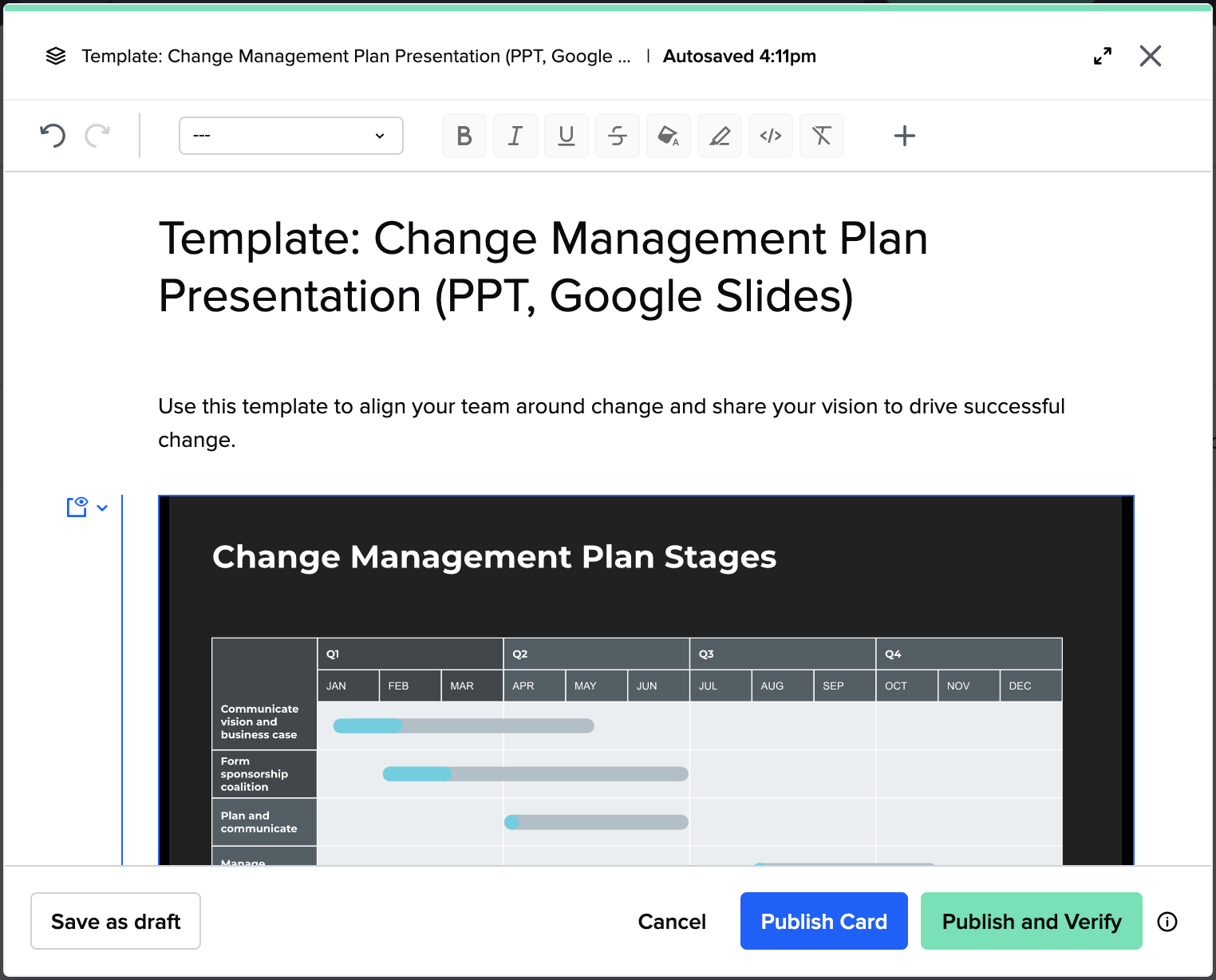
Upoważnij nowych pracowników do uzyskania pomocy, gdy jej potrzebują
Guru zapewnia integrację czatu, abyś mógł być na bieżąco z nowym członkiem zespołu, gdziekolwiek jesteś. Możesz zintegrować Guru w swoim kanale Slack swojej firmy i udostępnić go dowolnemu pracownikowi.
Jeśli twój nowy pracownik czuje się przytłoczony nową wiedzą, skorzystaj z wyzwalaczy wiedzy firmy Guru, aby dostarczyć najbardziej istotne informacje do Twoich pracowników.
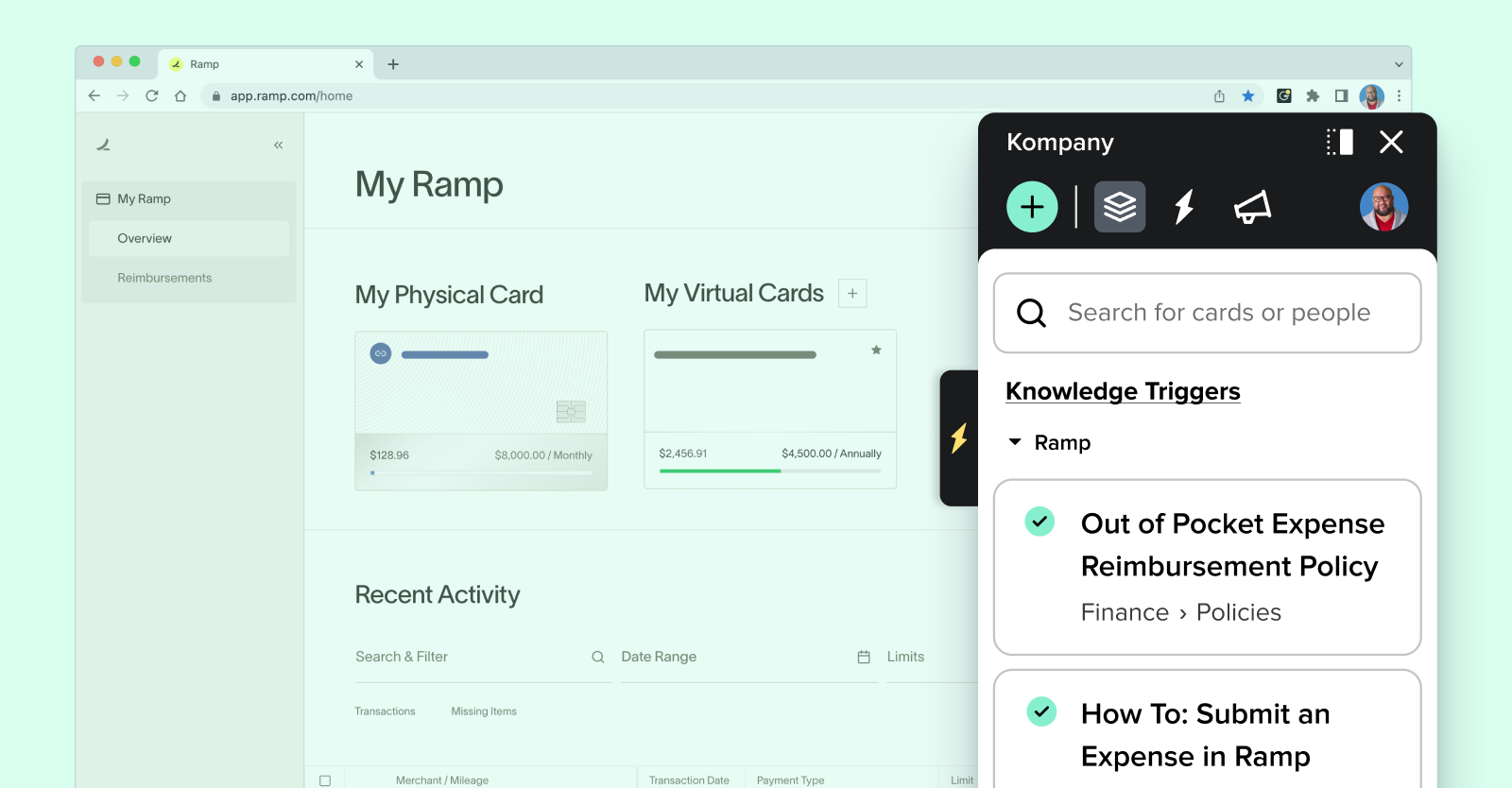
Obniż koszty onboardingu
Średni koszt onboardingu jednego pracownika wynosi ponad 4700 dolarów i będzie tylko wzrastał z każdym rokiem.
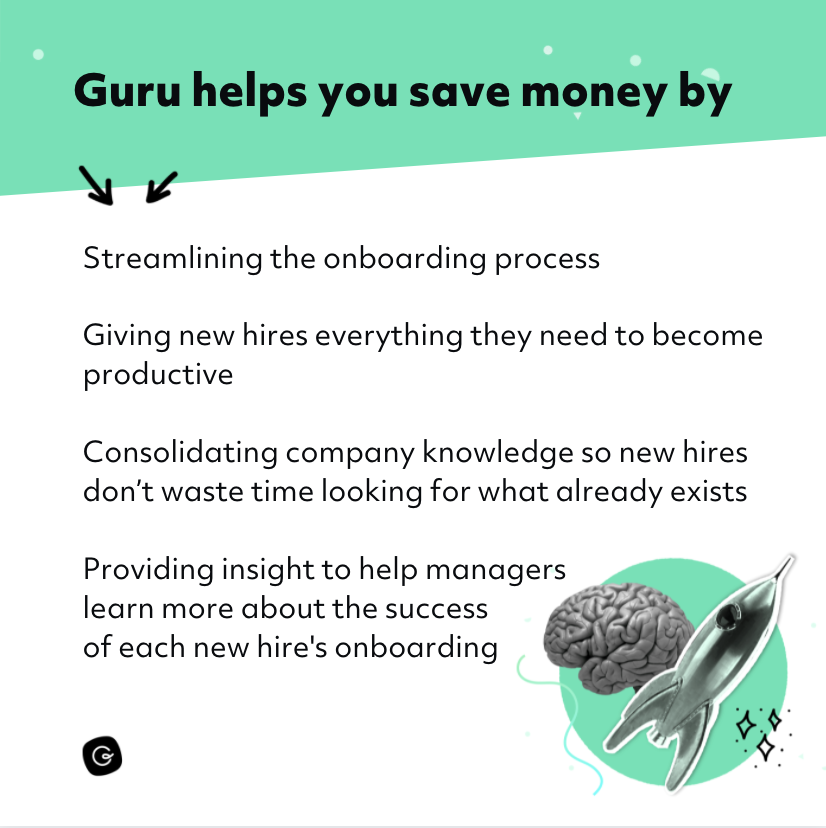
Analityka w czasie rzeczywistym, aby poprawić proces onboardingu
Jak dowiedzieć się, czy nowy pracownik potrzebuje pomocy? Guru zapewnia dane na poziomie użytkownika, które pokazują postępy, jakie nowy pracownik robi w procesie onboardingu. Możesz zobaczyć słowa kluczowe, których najczęściej szukają i co czytają.
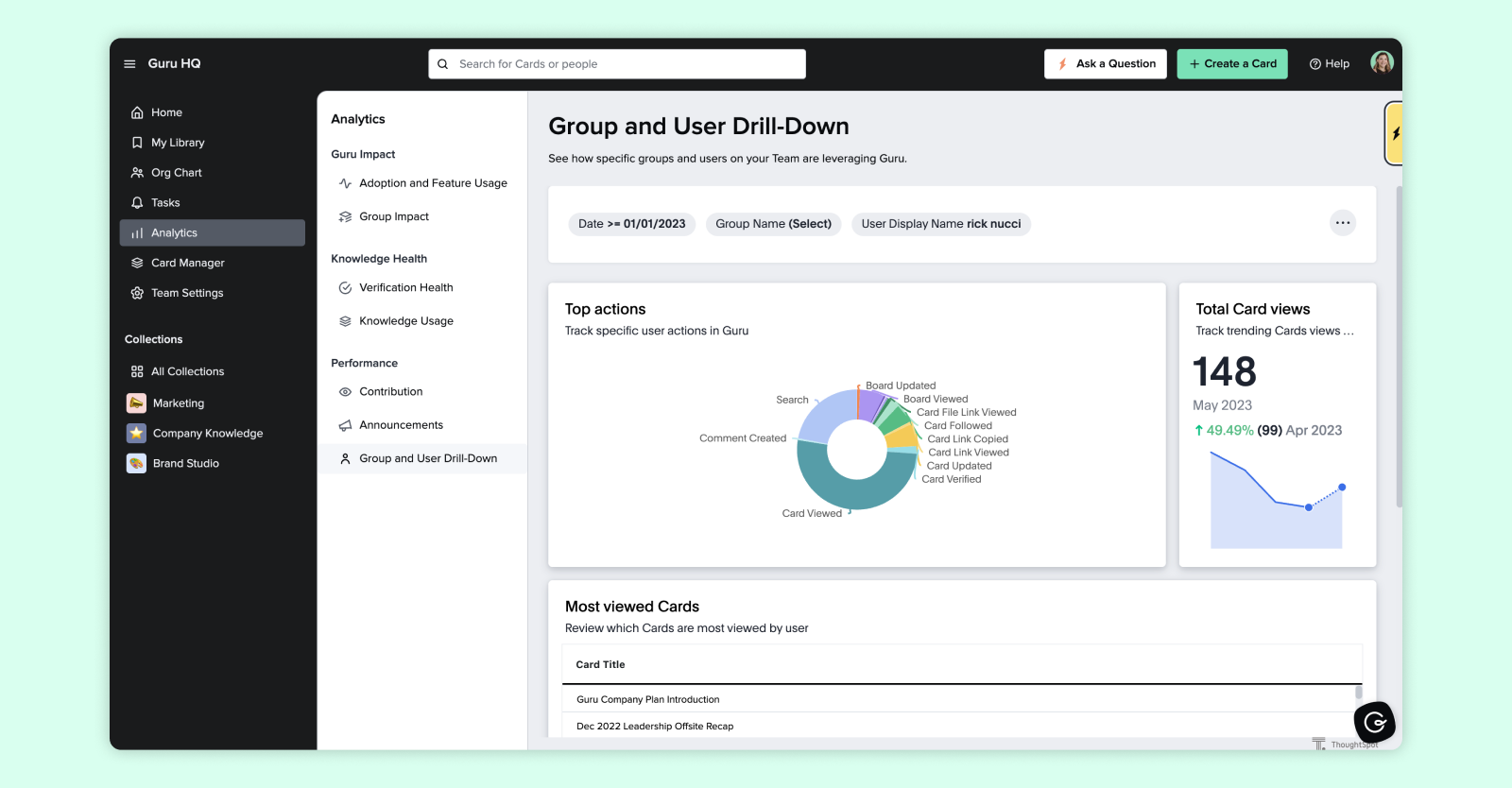
Chcesz wiedzieć, czy nowi pracownicy przeczytali ważny dokument, który wysłałeś? Skorzystaj z danych na poziomie karty Guru, aby upewnić się, że wszyscy widzieli informacje, które udostępniłeś. Jeśli nie przeczytali konkretnej karty, możesz skontaktować się i przypomnieć im.
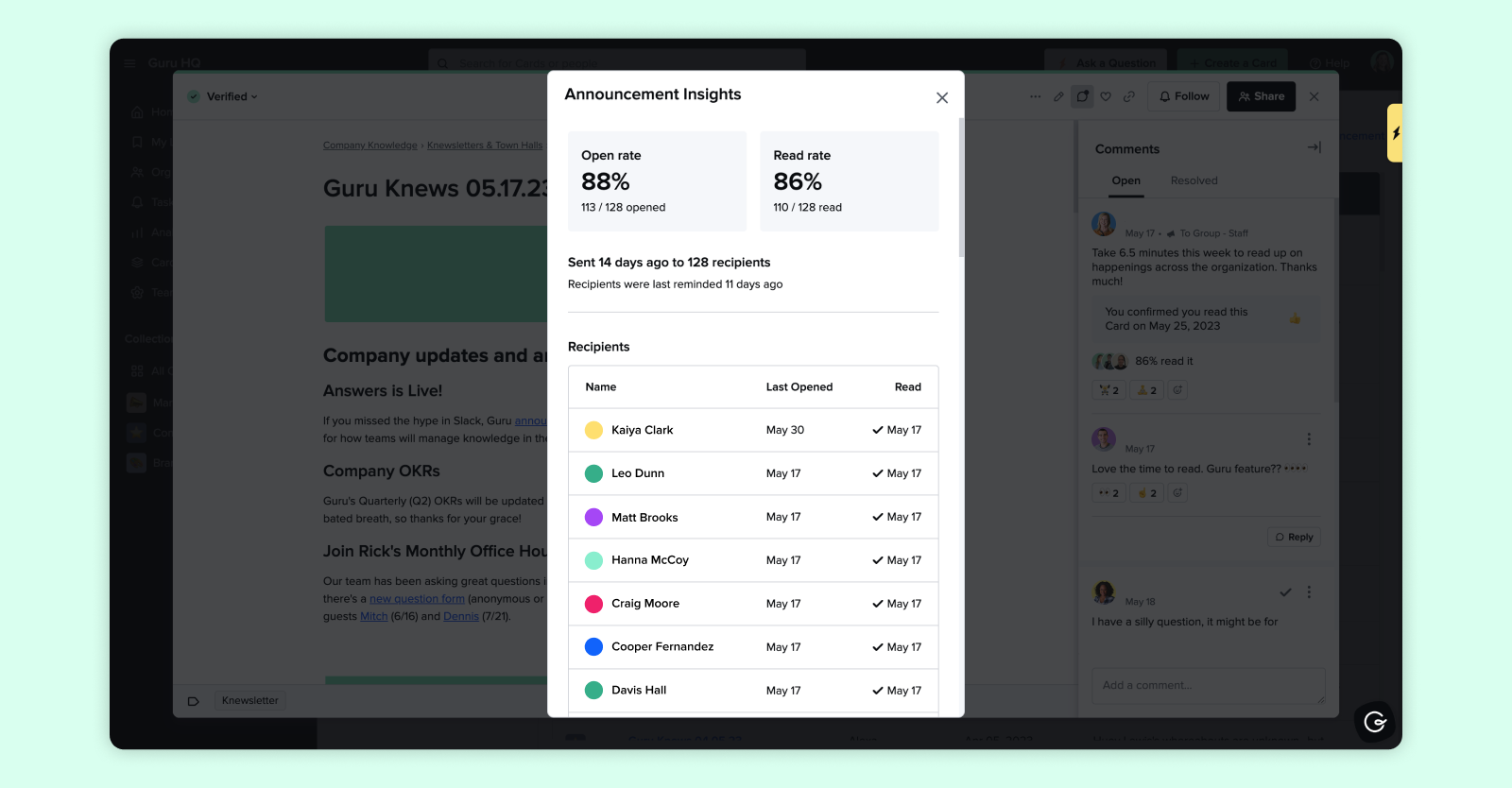
Ciekawe, jak Guru korzysta z Guru w onboardingu pracowników? Sprawdź ten post od Hillary Curran, dyrektor ds. doświadczeń klientów w Guru.
Jaki jest ROI efektywnego programu onboardingu?
Szczęśliwi pracownicy pomagają firmom odnosić sukcesy. Zgodnie z danymi Glassdoor, efektywny onboarding może poprawić utrzymanie nowych pracowników o nawet 82%.
Doskonały proces onboardingu umożliwia pracownikom szybsze osiągnięcie pełnej kompetencji i rozpoczęcie przynoszenia korzyści dla Twojej firmy.
Kilka sposobów, w jaki firmy realizują ROI z doskonałego onboardingu, obejmuje:
- Automatyzacja zadań onboardingu
- Zwiększenie efektywności w całej firmie
- Dodanie czasu na koncentrację
- Nadanie nowym pracownikom pewności siebie
- Skrócenie czasu, jaki nowi pracownicy potrzebują, aby się zaklimatyzować i zaaklimatyzować
- Obniżenie kosztów szkolenia nowych pracowników
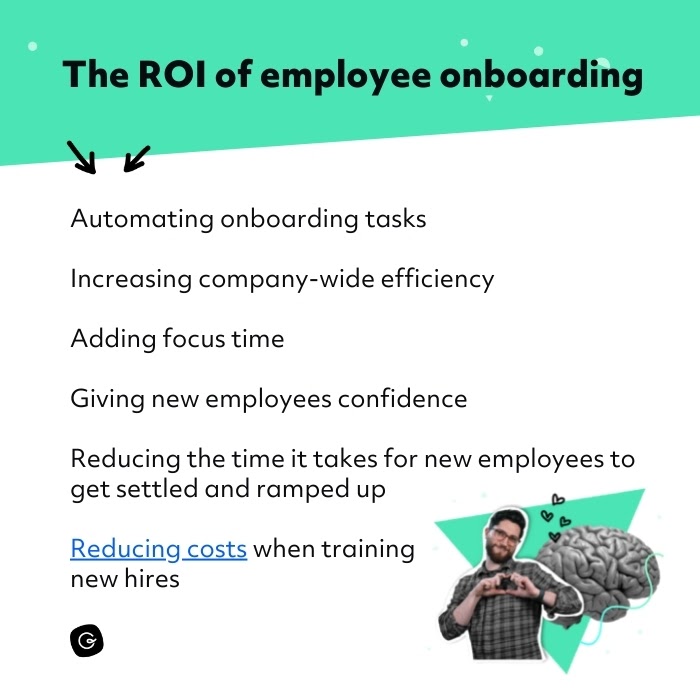
Wbudowanie onboardingu pracowników w kulturę firmy
Uczynienie onboardingu częścią Twojej kultury sprawia, że nowi pracownicy czują się mile widziani, zaangażowani i chętni do pomagania w rozwoju Twojej firmy. Jednak sukces onboardingu nie nastąpi bez uporządkowanego procesu. Jeśli wszystkie zasoby onboardingu i szkolenia są rozproszone po różnych narzędziach i jednorazowych wiadomościach Slack, łatwo jest sprawić, że nowi pracownicy poczują się zestresowani i osamotnieni.
Zainwestuj w oprogramowanie do onboardingu, które konsoliduje wszystkie materiały, których nowi pracownicy potrzebują, aby dobrze wystartować. To doskonały sposób na wzmocnienie ich pozycji i poprawę ogólnej produktywności.
Wydałeś dużo pieniędzy i czasu na rekrutację idealnego pracownika. Dziś jest ich pierwszy dzień i chcesz zrobić świetne wrażenie. Jeśli wszystko dobrze pójdzie, będą mniej zestresowani, szybko się osiedlą i staną się cennym członkiem Twojego zespołu. Jeśli się pomylisz, mogą odejść po kilku miesiącach, ponieważ będą sfrustrowani i nie będą mieli narzędzi do osiągnięcia sukcesu.
Niestety, niewielu menedżerów zatrudniających właściwie przeprowadza onboarding. Według Gallupa, tylko 12% pracowników jest zadowolonych ze swojego onboardingu. Raport HBR pokazuje również, że 23% pracowników odchodzi przed rocznicą swojej pierwszej pracy. Wynika to z tego, że zły proces onboardingu prowadzi do niższej morale, mniejszej pewności siebie, niskiego zaangażowania pracowników i braku zaufania do organizacji.
Dobry proces onboardingu zapewnia nowym pracownikom narzędzia i zasoby, których potrzebują, aby efektywnie wykonywać swoją pracę. Zmniejsza również rotację, pomaga nowym pracownikom zrozumieć, czego się od nich oczekuje, i ułatwia budowanie relacji między współpracownikami.
Ten artykuł daje Ci wszystko, co potrzebne do stworzenia skutecznego procesu onboardingu, zaczynając od listy kontrolnej onboardingowej, abyś mógł się zorganizować. Zapewnia, że Twoi nowi pracownicy nie czują się przytłoczeni w swoim pierwszym dniu, ale są ostrożnie prowadzeni przez proces poznawania kultury Twojej firmy, zrozumienia zadań i uzyskiwania potrzebnego wsparcia w rozwoju.
Czym jest onboarding?
Onboarding to proces, w którym nowi pracownicy nabywają umiejętności, wiedzę i możliwości potrzebne do stania się produktywnymi pracownikami organizacji.
Jednak onboarding to coś więcej niż tylko dostarczanie materiałów szkoleniowych i podpisywanie dokumentów. Zrobiony prawidłowo, to pierwszy krok w budowaniu lojalności wobec Twoich pracowników, co oznacza, że prawdopodobnie zostaną na dłużej.
Według HRCI, dobrze przeprowadzony onboarding prowadzi do tego, że 58% nowych pracowników zostaje w firmie przez co najmniej trzy lata. Glassdoor również stwierdza, że solidny proces onboardingu może pomóc nowym pracownikom osiągnąć do 70% wydajności po rozpoczęciu nowej pracy.
Jednak skuteczny proces onboardingu to nie tylko wypełnianie dokumentów i dyktowanie zasad. To Twoja okazja jako menedżera, aby zrobić wspaniałe pierwsze wrażenie i pokazać nowym pracownikom, że wybrali właściwą firmę.

Czym jest lista kontrolna onboardingowa?
Lista kontrolna onboardingu to sposób, w jaki menedżerowie zatrudniający organizują kroki związane z wprowadzaniem nowych pracowników na ich pierwsze dni i miesiące w firmie.
Lista kontrolna zapewnia punkt wyjścia dla procedur specyficznych dla określonego stanowiska. Należy jednak zauważyć, że wypełnienie listy kontrolnej onboardingu niekoniecznie przekłada się na skuteczny onboarding.
Najlepszy proces onboardingu znajduje równowagę między potrzebami pracownika, pomagając mu wczuć się w kulturę firmy, a praktycznymi momentami, które są nieplanowane. Najlepszy proces onboardingu znajduje równowagę pomiędzy potrzebami pracownika, pomagając mu wczuć się w kulturę firmy, a praktycznymi momentami, które są nieplanowane.
Co należy uwzględnić w liście kontrolnej onboardingu?
Oto kilka rzeczy, które powinna zawierać każda lista kontrolna onboardingu:
- Proces rekrutacji
- Rola pracownika
- Ustalanie celów
- Szkolenie w pracy
- Wprowadzenie do kultury firmy
- Terminy na konsultacje
- Spotkanie z innymi pracownikami lub przełożonymi
- Dokumentacja
- Poznawanie produktu
Lista kontrolna przed onboardingu
Według Aberdeen, firmy, które przeprowadzają pre-onboarding zatrzymują 81% nowych pracowników w pierwszym roku zatrudnienia.
Celem jest poinformowanie nowych pracowników, czego mogą się spodziewać w pierwszych dniach i czego firma oczekuje od nich w dłuższym okresie. Zobacz, jak Asana prowadzi swój proces pre-onboardingu.
Wyślij powitalny e-mail do nowego pracownika
Powitalny e-mail to dokument, który wysyłasz do nowego pracownika, aby go przywitać i przygotować na jego pierwszy dzień. Twoim celem jest, aby poczuli się doceniani i zaakceptowani jako część Twojego zespołu. Będziesz także musiał dostarczyć przydatne szczegóły, takie jak co się wydarzy i gdzie należy pójść.

Pisząc powitalny e-mail, potwierdź szczegóły, takie jak lokalizacja biura (dla ról hybrydowych lub stacjonarnych), data rozpoczęcia i godzina. Powiedz im, do kogo mają się zgłosić i czy powinni coś zabrać ze sobą, takie jak informacje dotyczące zabezpieczeń społecznych i dane bankowe.
Ogólnie rzecz biorąc, chcesz, aby pracownik czuł się optymistycznie i podekscytowany pracą z Tobą, a nie wystraszony i przytłoczony.
Oto kilka sposobów na dostosowanie swojego e-maila:
- Bądź osobisty
- Pokaż ekscytację
- Rozważ formatowanie
- Pokaż ducha swojej firmy
- Zapytaj ich, czy mają jakieś pytania lub wątpliwości dotyczące swojego pierwszego dnia
Porada: Rozważ przypisanie swojemu nowemu pracownikowi kolegi. Niech się z nimi skontaktuje, aby powitać nowego pracownika i ustalić czas na przywitanie oraz odpowiedź na wszelkie pytania.
Wyślij e-mail do istniejących pracowników
E-mail do istniejących pracowników to okazja, aby poinformować zespół o nowym pracowniku. Podziel się szczegółami na temat doświadczenia zawodowego pracownika, tła, edukacji i zestawu umiejętności. Zbuduj pozytywny wizerunek, aby pracownicy mogli łatwiej nawiązać relacje z nowym pracownikiem.
Zachęć również członków zespołu do dzielenia się swoją wiedzą i spędzania czasu na przedstawianiu siebie i tego, co robią w firmie.
Omów role i cele z przełożonym
Do kogo nowy pracownik będzie się zgłaszał? Jakie będą ich obowiązki i odpowiedzialności? Upewnij się, że omówiłeś to z ich przełożonymi i innymi zainteresowanymi stronami.
Przygotuj biuro dla nowych pracowników
Bez względu na to, czy to biurko, sala czy stół, upewnij się, że jest gotowe i wyposażone przed rozpoczęciem pracy nowego pracownika. Kiedy nowy pracownik zobaczy, że ma przygotowane dedykowane miejsce pracy, pokaże to, że włożono wysiłek w to, aby poczuł się mile widziany.

Listy kontrolne onboardingu pracowników
Agenda onboardingu na pierwszy dzień
Wycieczka po biurze
Zakładając, że nie są to pracownicy wykonujący pracę zdalną, w pierwszym dniu zapewnij nowym pracownikom zorganizowaną wycieczkę po firmie i przedstaw ich współpracownikom. Poza pokazaniem im, gdzie co jest, wycieczka powinna także sprawić, że Twoi nowi pracownicy będą entuzjastycznie nastawieni do codziennego przychodzenia do pracy. Więc jeśli masz fajny pokój gier, centrum jogi lub jakieś innowacyjne urządzenia, z których jesteś dumny, nie krępuj się ich pokazywać.
Pomóż swojemu nowemu pracownikowi przygotować miejsce pracy
W biurze?
Pokaż im swoje nowe biuro, narzędzia, z którymi będą pracować, oraz współpracowników, z którymi mogą dzielić przestrzeń. Nie zapomnij podzielić się zasadami firmy dotyczącymi projektowania i dostosowywania miejsca pracy.
Pracujesz zdalnie?
Jeśli Twoja firma ma budżet na pomoc swojemu nowemu pracownikowi w stworzeniu komfortowego domowego biura, upewnij się, że podzielisz się wszelkimi wskazówkami w pierwszym dniu.
Poproś nowych pracowników o wypełnienie dokumentów HR
Gdy mają już biurko, zapewnij nowym pracownikom formularze HR potrzebne do złożenia dokumentacji dotyczącej płac, świadczeń, podatków i innych. Poinformuj ich, co należy zrobić w razie potrzeby pomocy w wypełnianiu formularzy.
Spotkanie z menedżerami i kierownikami
Po tym, jak nowi pracownicy zapoznają się ze swoimi współpracownikami i przetestują swoje stanowiska pracy, czas na spotkanie z kierownikami lub przełożonymi. Aby zaoszczędzić czas, zorganizuj otwarte spotkanie orientacyjne, na którym menedżerowie i kierownicy przedstawią się nowym pracownikom i podzielą się kilkoma słowami zachęty. W przypadku mniejszych firm spotkanie z menedżerami i kierownikami może odbyć się w formie indywidualnych spotkań.
Przydziel materiały szkoleniowe
Zapewnij swoim nowym pracownikom zasoby potrzebne do wykonywania swojej pracy i osiągania pożądanych wyników. Możesz użyć Guru, aby udostępnić dokumenty szkoleniowe i śledzić postępy onboardingu pracowników. Guru ułatwia pracownikom naukę we własnym tempie i pozwala Ci śledzić, co przeczytali.
Omów oczekiwania
Jak będzie determinowany sukces? Ustalenie jasnych oczekiwań wobec pracowników wyposażają ich w narzędzia do monitorowania swojej wydajności i dążenia do najlepszych wyników.
Omów kulturę firmy
Kultura firmy wykracza poza wytyczne i zasady, które pracownicy muszą przestrzegać wewnątrz i na zewnątrz miejsca pracy.
Silna kultura firmy nie tylko przyciąga najlepszych kandydatów, ale także pomaga zatrzymać pracowników. Komunikowanie kultury firmy podczas onboardingu pomaga pracownikom zrozumieć wartości firmy, ich role i to, jak się pokrywają. Kultura, którą pracownicy kochają, poprawia również wydajność, wyniki i zaangażowanie.
Przydziel mentora lub kolegę
Według Harvard Business Review, przydzielenie mentora during onboardingu zapewnia, że nowy pracownik będzie produktywny w ciągu pierwszych 90 dni w nowej pracy.
Programy mentorskie to świetny sposób, aby nowi pracownicy nauczyli się umiejętności praktycznych od starszych pracowników. Mentoring synchronizuje cele organizacyjne z celami zawodowymi pracowników i daje im poczucie zaangażowania, co prowadzi do zwiększonej satysfakcji z pracy.
Zabierz ich na lunch
Jeśli Twoja organizacja nie może sobie pozwolić na zabranie każdego nowego pracownika na wykwintny lunch, to zrozumiałe. Alternatywą jest uczczenie nowych pracowników napojami, przekąskami, brawami lub czymkolwiek innym, co pokazuje, że cieszysz się, że ich masz na pokładzie.
Lista kontrolna onboardingu na pierwszy tydzień
Onboarding nigdy się nie kończy. To ciągły proces od momentu przybycia nowego pracownika aż do dnia ich odejścia. Pierwszy tydzień to czas, aby upewnić się, że nowy pracownik jest zaangażowany w kulturę firmy i wzmocnić wartość, jaką w nich widzisz. W związku z tym zadania powinny być powiązane z kulturą korporacyjną.
Kilka rzeczy do zrobienia w pierwszym tygodniu onboardingu to:
- Codziennie sprawdzaj, jak przystosowują się do nowego środowiska pracy
- Zaplanuj szkolenie
- Pokaż im, jak korzystać z oprogramowania firmy
- Przedstaw im innych członków zespołu
- Rekomendacja przydatnych zasobów do rozwoju
- Organizacja aktywności towarzyskich, aby pomóc nowym pracownikom w nawiązaniu więzi z kolegami
- Wykorzystaj opinię pracowników do poprawy procesu onboardingu
Lista kontrolna onboardingu na pierwszy miesiąc
Kilka rzeczy do zrobienia w ciągu pierwszych 30 dni onboardingu obejmuje:
- Organizuj cotygodniowe spotkania z nowymi pracownikami
- Włącz ich w bieżące projekty, ale nic zbyt skomplikowanego
- Pomóż im poznać platformy specyficzne dla firmy, zasoby szkoleniowe i systemy intranetowe
- Dostarcz opinie na temat konkretnych zadań. Pamiętaj, aby postępować łagodnie, ponieważ wciąż uczą się
- Ułatw budowanie relacji
- Przeprowadź ankietę onboardową, aby określić, jak dobrze nowy pracownik zintegrował się z Twoją firmą
- Wykonaj przegląd postępów i zaplanuj odpowiednie szkolenie na podstawie wyników przeglądu
Lista kontrolna onboardingu na 90 dni
Po 90 dniach kilka rzeczy do zrobienia obejmuje:
- Zachęć swojego pracownika do samodzielnego pracy nad projektami i ponoszenia odpowiedzialności za swoją pracę
- Regularnie kontaktuj się z przełożonym w celu uzyskania opinii o KPI i metrykach na przyszłość
- Przeglądaj cele wydajności, aby upewnić się, że są realistyczne i osiągalne
- Zbierz opinie pracowników na temat programu orientacji nowych pracowników
- Kontynuuj ułatwianie socjalizacji i budowania relacji w organizacji
- Rozważ shadowing, jeśli Twój pracownik ma trudności z zaklimatyzowaniem się lub osiąganiem KPI
Lista kontrolna onboardingu na 6 miesięcy
Jeśli dotarli do kamienia milowego 6 miesięcy, to niesamowite! Zorganizuj ocenę wydajności, aby przeanalizować osiągnięcia i omówić cele do osiągnięcia w roku.
Przegląd po roku
Do końca roku nowy pracownik powinien być w pełni zintegrowany w firmie. Dawaj swoim pracownikom opinie na temat ich wydajności i pokaż im obszary, które mogą poprawić.

Szablony list kontrolnych onboardingu dla różnych działów
Nie musisz tworzyć listy kontrolnej onboardingu od podstaw. W Guru mamy kilka szablonów onboardingu, które możesz dostosować do potrzeb onboardingu swojego pracownika. Możesz przetestować nasz darmowy szablon onboardingu dla menedżerów HR, przedstawicieli sprzedaży, pracowników IT i pracowników zdalnych.
Szablon onboardingu HR
Szablon onboardingu Guru dla zasobów ludzkich zawiera listę działań na każdym etapie procesu onboardingu. Możesz stworzyć listę zadań, oznaczyć status każdego ukończonego zadania i dodać notatki.
Szablon onboardingu dla menedżerów
Menedżerowie powinni korzystać z tego szablonu listy kontrolnej, aby upewnić się, że obejmują każdy etap programu onboardingu. Szablon zawiera odpowiedzialności związane z onboardingu od wstępu, prowadzenia ich przez pierwszy dzień, zapewniania ocen wydajności i uzyskiwania opinii.
Szablon onboardingu dla zespołów sprzedażowych
Istnieje wyjątkowa kultura w zespole sprzedażowym, która wymaga unikalnego szkolenia. Skorzystaj z tej listy kontrolnej onboardingu sprzedaży, aby zakończyć szkolenie dotyczące marketingu, przypadków użycia produktów, misji firmy i taktyk sprzedażowych.
Szablon onboardingu dla IT
Bez odpowiednich narzędzi nowi pracownicy doświadczają niespójności, które uniemożliwiają im wykonywanie swojej pracy. Dział IT regularnie zapewnia wsparcie, aby zapobiec zmarnowanemu czasowi i zapewnić płynne onboardowanie. Skorzystaj z tej listy kontrolnej, aby upewnić się, że zespół IT zapewnia nowym pracownikom dostęp do firmowego konta e-mail, urządzeń do obliczeń, dostępu do systemów wewnętrznych i uprawnień do bezpieczeństwa.
Szablon onboardingu dla pracowników zdalnych
Onboarding pracowników zdalnych może być trudny, ponieważ wszystko odbywa się za ekranem. Jednak cele pozostają takie same. Widoczna różnica to brak spontanicznych okazji do tworzenia więzi zespołowych i osobistego uczenia się, które pomagają nowym pracownikom zorientować się w sytuacji.
Użyj tego szablonu onboardingu dla zdalnych pracowników, aby stworzyć proces onboardingu, który szybko wdroży nowego pracownika na właściwą ścieżkę.
Jak korzystać z Guru w onboardingu pracowników?

Elastyczny onboarding
Rozpoczęcie nowej pracy jest już stresujące. Szukając materiałów onboardujących na wielu platformach, staje się to jeszcze bardziej stresujące. Z Guru nowi pracownicy mogą uzyskać dostęp do całej wiedzy związanej z onboardowaniem z jednej centralnej platformy, zamiast poruszać się po oddzielnych rozwiązaniach.
Guru jest również na tyle elastyczny, że umożliwia pracownikom przyswajanie wiedzy w ich własny sposób i w ich własnym tempie, zamiast zmuszać ich do ukończenia modułów w określonym porządku. Chcemy, aby Twój zespół miał autonomię od pierwszego dnia, co następuje poprzez dostosowanie onboardingu, aby zaangażować nowego członka zespołu.
Cała wiedza Twojej firmy w jednym miejscu
Kiedy wiedza jest łatwa do znalezienia, produktywność wzrasta. Guru pozwala ci zebrać wszystkie polityki firmowe, opisy stanowisk, procesy zespołowe, moduły szkoleniowe i inne dokumenty onboardujące w jednym miejscu.
Skorzystaj z naszego edytora kart, aby dodać wiele formatów treści, takich jak PDF, obrazy i filmy. Możesz także dodać treści z innych aplikacji, takich jak Google Docs. Chcesz wprowadzić zmiany? Użyj naszego edytora w aplikacji, aby zaktualizować osadzone treści bezpośrednio w Guru.

Upoważnij nowych pracowników do uzyskania pomocy, gdy jej potrzebują
Guru zapewnia integrację czatu, abyś mógł być na bieżąco z nowym członkiem zespołu, gdziekolwiek jesteś. Możesz zintegrować Guru w swoim kanale Slack swojej firmy i udostępnić go dowolnemu pracownikowi.
Jeśli twój nowy pracownik czuje się przytłoczony nową wiedzą, skorzystaj z wyzwalaczy wiedzy firmy Guru, aby dostarczyć najbardziej istotne informacje do Twoich pracowników.

Obniż koszty onboardingu
Średni koszt onboardingu jednego pracownika wynosi ponad 4700 dolarów i będzie tylko wzrastał z każdym rokiem.

Analityka w czasie rzeczywistym, aby poprawić proces onboardingu
Jak dowiedzieć się, czy nowy pracownik potrzebuje pomocy? Guru zapewnia dane na poziomie użytkownika, które pokazują postępy, jakie nowy pracownik robi w procesie onboardingu. Możesz zobaczyć słowa kluczowe, których najczęściej szukają i co czytają.

Chcesz wiedzieć, czy nowi pracownicy przeczytali ważny dokument, który wysłałeś? Skorzystaj z danych na poziomie karty Guru, aby upewnić się, że wszyscy widzieli informacje, które udostępniłeś. Jeśli nie przeczytali konkretnej karty, możesz skontaktować się i przypomnieć im.

Ciekawe, jak Guru korzysta z Guru w onboardingu pracowników? Sprawdź ten post od Hillary Curran, dyrektor ds. doświadczeń klientów w Guru.
Jaki jest ROI efektywnego programu onboardingu?
Szczęśliwi pracownicy pomagają firmom odnosić sukcesy. Zgodnie z danymi Glassdoor, efektywny onboarding może poprawić utrzymanie nowych pracowników o nawet 82%.
Doskonały proces onboardingu umożliwia pracownikom szybsze osiągnięcie pełnej kompetencji i rozpoczęcie przynoszenia korzyści dla Twojej firmy.
Kilka sposobów, w jaki firmy realizują ROI z doskonałego onboardingu, obejmuje:
- Automatyzacja zadań onboardingu
- Zwiększenie efektywności w całej firmie
- Dodanie czasu na koncentrację
- Nadanie nowym pracownikom pewności siebie
- Skrócenie czasu, jaki nowi pracownicy potrzebują, aby się zaklimatyzować i zaaklimatyzować
- Obniżenie kosztów szkolenia nowych pracowników

Wbudowanie onboardingu pracowników w kulturę firmy
Uczynienie onboardingu częścią Twojej kultury sprawia, że nowi pracownicy czują się mile widziani, zaangażowani i chętni do pomagania w rozwoju Twojej firmy. Jednak sukces onboardingu nie nastąpi bez uporządkowanego procesu. Jeśli wszystkie zasoby onboardingu i szkolenia są rozproszone po różnych narzędziach i jednorazowych wiadomościach Slack, łatwo jest sprawić, że nowi pracownicy poczują się zestresowani i osamotnieni.
Zainwestuj w oprogramowanie do onboardingu, które konsoliduje wszystkie materiały, których nowi pracownicy potrzebują, aby dobrze wystartować. To doskonały sposób na wzmocnienie ich pozycji i poprawę ogólnej produktywności.


.webp)


.webp)
